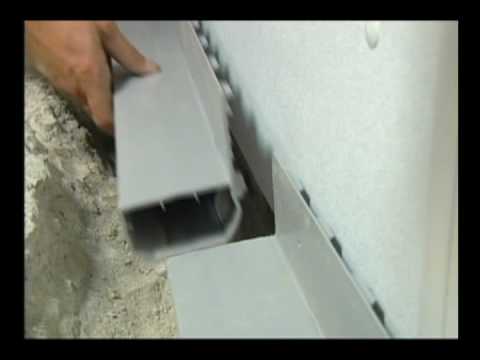Wet Basement Repair
Protect your home from odors and mildew by taking the necessary steps to keep moisture out of your basement.
The source of a wet basement is usually on the exterior of the house; therefore the best remedy will be done from the outside. But there are several interior basement repairs that should be attempted first before tackling a major water blockage job from the exterior.
Interior repairs
If your foundation is porous, water could be seeping through the walls and floors and turning into humidity in the basement. High humidity can cause odors and mildew.
Coat your walls and floor with a cement waterproofing material that will expand and harden once it enters the pores of the concrete. To apply the compound, wet your walls or floor, then brush or trowel the cement-based compound over the surface, making sure it’s forced into all cracks and crevices. Apply a second coat within 24 hours.
Humidity can also manifest itself in the form of condensation. Warm air is filed with water vapor. As warm air hits a colder surface, water drops or condensation forms Because basement walls are cold from being next to the cold ground, any warm air inside the basement or warm air coming into the basement through open windows or doors will form condensation on the wails. A heated basement with insulated and finished walls will help solve the problem, but if you prefer to leave your basement unfinished, invest in a dehumidifier to help reduce excess moisture in the air, and cover cold-water pipes with insulation to prevent condensation. Also make sure your clothes drier, which is the major cause of condensation in the house, is vented to the outside.
If there’s evidence of water puddling after a rainfall, you could have a crack or crevice in your foundation wall. Even cracks that don’t appear wet should be repaired, since they will eventually start leaking.
There are two types of crack — moving and stable. If a crack continues to enlarge, major repairs could be necessary. In this case, it’s best to consult a professional.
A stable crack can be repaired with a patching compound. To fix, chisel the crack wider, undercutting the hole so that it’s wider at the back. This keeps the patching
material from failing out. Brush or vacuum out any dust. Dampen the hole and fill it with a patching compound of 1 part cement to 3 parts sand A chemical additive should also be mixed in to prevent shrinkage ana assist bonding.
If you need to plug а crack while water is seeping through it, use a quick-setting hydraulic mortar. Water is added to the compound, which is then shaped into a plug. After the hole is undercut with a chisel, the plug s inserted and held in place until it hardens
If water is leaking througn the join at the floor and wall, an epoxy resin can be added to take а flexible seal. Chisel out the join, undercutting it on the inside. Vacuum out the dust and fill with the two-part epoxy mix. Use this method only if there has been a period of no rainfall.
Exterior repairs
If the inside wall treatments don’t solve your problem, then exterior waterproofing will be necessary. Exterior waterproofing tends to be more effective, because it prevents water from entering the walls in the first place.
A simple exterior remedy is to regrade the soil around the house so that it slopes gently away from the walls, forcing surface water to drain away from the house
Another method is digging a trench at the foundation. If the cracks are near the surface, dig down below them, patch the wall with asphalt and cover it with a plastic sheet. Backfill the hole with gravel to a depth of about 60cm (2ft), then cover with topsoil. Make sure the grade is slopng away from the house.
A more serious leakage problem lower on the basement wall could be caused by considerable water pressure. The remedy for th;s would involve digging a trench around the house down to the footings, covering the foundation wall with asphalt and plastic sheeting, and laying new drain tiles to collect the excess water and take it away from the foundation walls. Cover the drain tiles with a thick gravel bed and backfill the trench again, making sure the fill slopes gently away from the nouse.
EXTERIOR REPAIRS
To waterproof an exterior foundation wall, first dig a trench by the wall. Clean and fill all mortar cracks. When dry, apply a thick coat of sealer. If you need to remove groundwater, dig the trench to the base of the footings and lay new drain tiles with a slope of 12mm (1/2 in) per 30cm (1ft) leading to a sewer or dry well.
